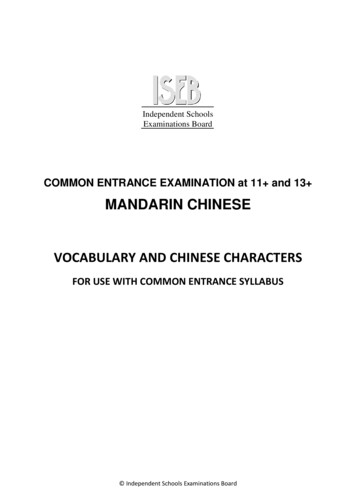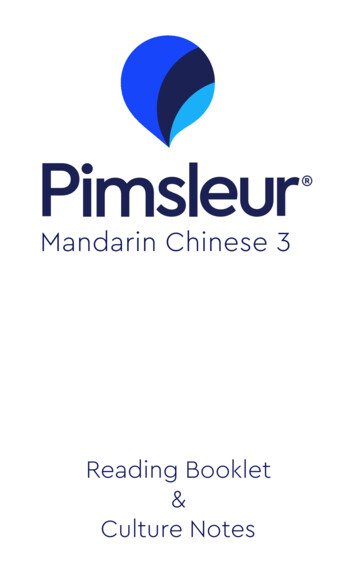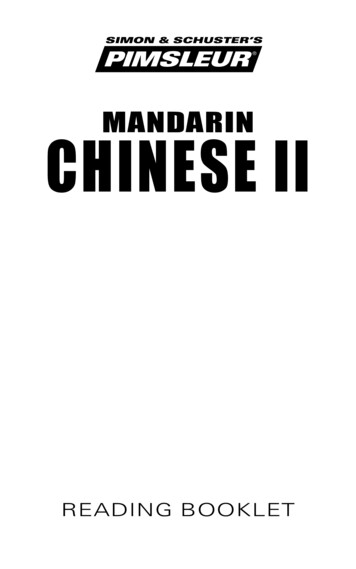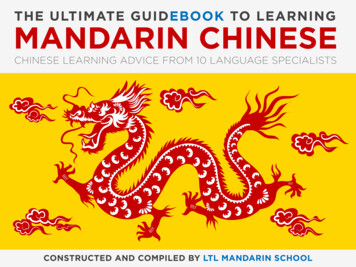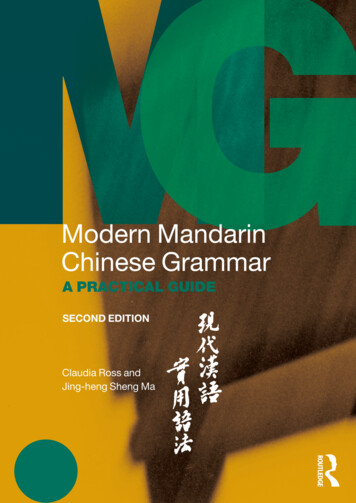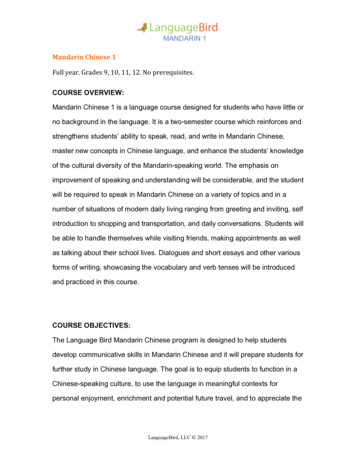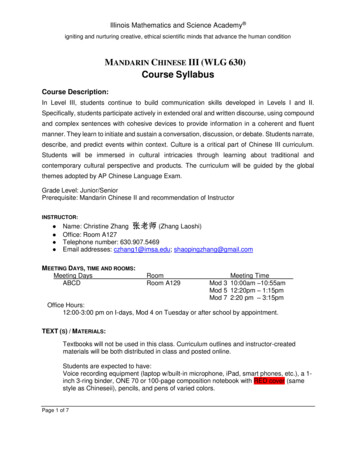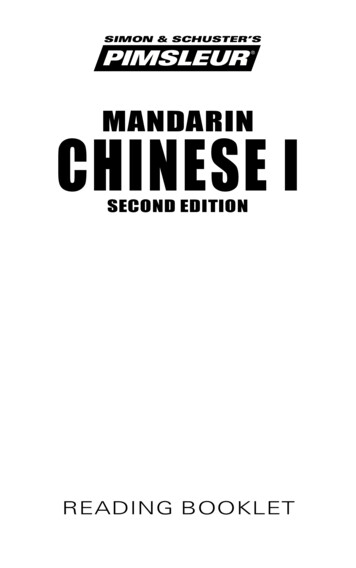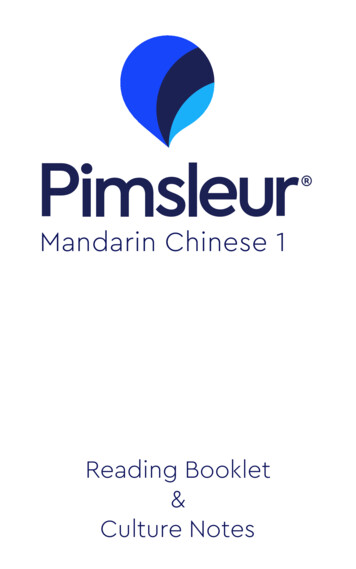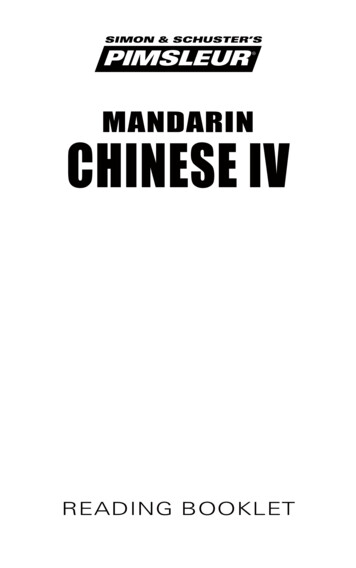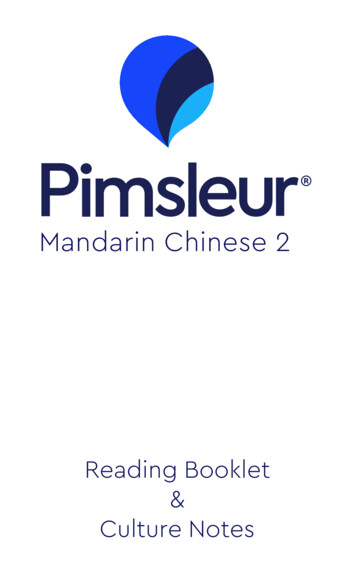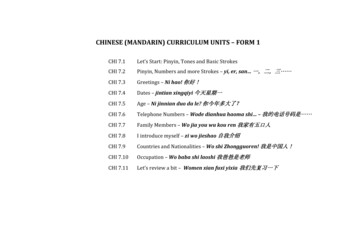
Transcription
CHINESE (MANDARIN) CURRICULUM UNITS – FORM 1CHI 7.1Let’s Start: Pinyin, Tones and Basic StrokesCHI 7.2Pinyin, Numbers and more Strokes – yi, er, san 一,二,三 CHI 7.3Greetings – Ni hao! 你好!CHI 7.4Dates – jintian xingqiyi 今天星期一CHI 7.5Age – Ni jinnian duo da le? 你今年多大了?CHI 7.6Telephone Numbers – Wode dianhua haoma shi – 我的电话号码是 CHI 7.7Family Members – Wo jia you wu kou ren 我家有五口人CHI 7.8I introduce myself – zi wo jieshao 自我介绍CHI 7.9Countries and Nationalities – Wo shi Zhongguoren! 我是中国人!CHI 7.10Occupation – Wo baba shi laoshi 我爸爸是老师CHI 7.11Let’s review a bit – Women xian fuxi yixia 我们先复习一下
Subject: Chinese (Mandarin)Unit code and title: CHI 7.1 Let’s Start: Pinyin, Tones and Basic StrokesStrand: Listening, Speaking, Reading and WritingForm 1Unit duration: 9 lessons of 40 minutes (6 hours)ObjectivesThe teacher will:1. Teach students how to recognise and pronounce vowels and consonants in Chinese. (Speaking and Listening)2. Teach students how to discern and reproduce the four tones in Chinese Mandarin. (Speaking and Listening)3. Teach students how to write syllables in Chinese using pinyin and use the appropriate tonal marks on the vowels to distinguish andvocalise the correct tone. (Writing and Reading)4. Teach students how to recognise and draw 8 of the basic strokes to form Chinese characters. (Reading and Writing)Key wordsPoints to noteResourcesPinyin,vowels, The peculiarity of Chinese (Mandarin) being a tonal language Easy Steps to Chinese 1, Textbook andconsonants,tones should be explained and introduced to the students from the Workbook,and tonal marks, very beginning. The teacher should introduce the vowels (a, o, Computer Lab, internet access, headphones,characters (hànzi),e, i, u, ü) and consonants (b, p, m, f, d, t , n, l, g, k, h, j, q, x, zh, ch, CD players. PowerPoint presentations andsh, r, z, c, s, y, w) in Chinese. By the means of interactive lessons, handouts given in class by the teacher.students should acquire the necessary skills to discern andreproduce the utterance of the four tones in Chinese http://www.uvm.edu/ chinese/PDF/PRC(Mandarin): i.e. ‘first tone’ mā, ‘second tone’ má, ‘third tone’ mǎ, Writing-Sheet.pdf‘fourth tone’ mà with the addition of a ‘neutral tone’ ma. It isalso important to note at this stage that the variation or http://www.uvm.edu/ chinese/PDF/PRCincorrect pronunciation of the tone on a given syllable implies a Character-Writing-Sheet.pdfchange in meaning: i.e. comparing mā (mother) with mǎ(horse). The students should learn how to place the correct http://chineseprintables.com/paper/rice A4.‘tonal mark’ on the vowel of each syllable. Some words have pdfneutral tones, so no tonal marks are need: i.e. bàba māma.The first 8 basic strokes (diǎn, héng, shù, piě, nà, tí, zhé, gōu)should also be introduced in this unit. By the end of this unit thestudent should be able to recognise the learnt strokes of givencharacters (hànzi) and draw them.
Teaching ObjectivesSpeaking, ListeningThe teacher will:Guide the students to pronouncethe four distinctive tones ofChinese Mandarin.Teach students how totransliterate Chinese syllablesinto Latin alphabet using pinyin.Writing, ReadingExamples of Teaching activitiesLearning OutcomesThe first step of the learning acquisition is achieved by The student will:repetition. The teacher should pronounce out loud thefour distinctive tones of Chinese and let the students Be made aware of the particular nature ofrepeat them out loud.spoken Mandarin and can compare andcontrast Chinese, Maltese and Englishsounds.The teacher shall introduce the vowels andconsonants of Chinese syllables in pinyin. Once the Reproduce the four distinctive tones of thestudents become aware of the tonal differences and Chinese language and recognise how theyhow these imply change in meaning, the teacher shall can change the meaning of words e.g. mā,,introduce the four ‘tonal marks’ to be placed on the má , mǎ and mà.syllables.Teach students how to place thecorrect tonal mark on syllables.By means of games, interactive whiteboard andPower-point presentations, the teacher should enablethe students to identify the correct ‘tonal mark’according to the syllable and tone.Distinguish the four distinctive tones ofspoken Mandarin and identify the change inthe meaning of words that occurs when thetone changes.Teach students how to recogniseand draw 8 of the basic strokesto form Chinese charactersStudents should be given specific sheets to startwriting and exercising on the correct movement of the Be able to recognise, name and draw thehand when drawing the first 8 basic strokes. These first 8 basic strokes.will be essential when forming the first Chinesecharacters. Attention should be given on precision anddirection of the strokes.
Subject: Chinese (Mandarin)Unit code and title: CHI 7.2 Pinyin, Numbers and more StrokesStrand: Listening, Speaking, Reading and WritingForm 1Unit duration: 9 lessons of 40 minutes (6 hours)ObjectivesThe teacher will:1. Teach students how to recognise and pronounce combinations of vowels and consonants in Chinese. (Speaking and Listening)2. Teach students how to discern and reproduce the four tones in Chinese Mandarin on different syllables. (Speaking and Listening)3. Teach students how to write more syllables in Chinese using pinyin and use the appropriate tonal marks on the vowels to distinguishand vocalise the correct tone. (Writing and Reading)4. Teach students how to recognise and draw more basic strokes to form Chinese characters. (Reading and Writing)5. Teach students 5 basic rules of writing characters.6. Teach students numbers from 1 to 10 in Chinese characters and pinyin.Key wordsPoints to noteResourcesCharacter writing rules, In this unit students should learn more basic strokes in Easy Steps to Chinese 1, Textbook and Workbook,一,二,三,四,五, order to form Chinese characters. More vowel-consonant Computer Lab, internet access, headphones, CDpatterns in Chinese should also be introduced: the players. PowerPoint presentations and handouts六,七,八,九,十students should learn how to recognise and reproduce given in class by the teacher.Strokeorderand different syllables in Chinese.The teacher should now introduce the numbers from 1 to http://chineseprintables.com/paper/field A4.pdfcounting10 in pinyin and characters.The teacher should also explain the first five basic rulesof writing characters, i.e. 十,三,什,小,因.The students should also learn the concept of strokecounting and order and start to write from one-strokecharacter to ten-stroke characters.
Teaching ObjectivesSpeaking, ListeningThe teacher will:Guide the students to pronouncesyllables in Chinese payingattention to precise vocalisationof vowels, consonants and thefour tones.Teach students how to countfrom 1 to 10 always payingattention on the tones.Writing, ReadingTeach students somefundamental rules when drawingChinese characters.Teach students the numbersfrom 1 to 10 in both pinyin andcharacter.Teach students how to recogniseand draw 8 of the basic strokesto form Chinese charactersExamples of Teaching activitiesThe teacher should still pronounce out loud the fourdistinctive tones of Chinese and let the studentsrepeat them out loud. The teacher shall introducemore syllables with tonal marks and students shouldbe asked to pronounce them paying particularattention to the vowel-consonant combination andtone. By means of games, interactive whiteboard andPower-point presentations, the teacher should enablethe students to identify the correct pronunciation ofrandom syllables in Chinese.Learning OutcomesThe student will:Reproduce the four distinctive tones whenvocalising syllables.Be able to count from 1 to 10.The teacher shall introduce the numbers from 1 to 10in both pinyin and characters.When teaching the basic fundamental rules to drawChinese characters, the students should be made Be able to draw the first Chinese charactersaware of the importance of stroke order and counting. bearing in mind the correct stroke orderStudents should get accustomed to the concept of and fundamental rules.counting strokes when learning a new Chinesecharacter right from the beginning. This will enablethem to memorise characters efficiently and quickly.Students should be given specific sheets to startwriting and exercising on the correct movement of thehand when drawing basic strokes and the numbers incharacters. These will be essential when forming thefirst Chinese characters. Attention should be given onprecision and direction of the strokes.
Subject: Chinese (Mandarin)Unit code and title: CHI 7.3 Greetings - Ni hao! 你好!Strand: Listening, Speaking, Reading and WritingForm 1Unit duration: 9 lessons of 40 minutes (6 hours)ObjectivesThe teacher will:1. Teach students how to recognise and pronounce combinations of vowels and consonants in Chinese introducing the concept ofinitials and finals. (Speaking and Listening)2. Teach students how to discern and reproduce the four tones in Chinese Mandarin on different syllables. (Speaking and Listening)3. Teach students how to recognise and draw more basic strokes to form Chinese characters. (Reading and Writing)4. Teach students the structure and stroke order of 15 Chinese characters. (Writing and Reading)5. Teach students how to greet formally and informally. (Speaking and Listening)6. Teach students how to introduce themselves saying their names and their classmates’ names. (Speaking and Listening)Key wordsPoints to noteResourcesSyllables: initial finalIn this unit students should learn how to write 15 Chinese Easy Steps to Chinese 1, Textbookcharacters paying attention to stroke order: 你,您,好,再,见, and �,我,小,月,大,生.再见The teacher should explain the difference between 你 and 您 when Computer Lab, internet access,headphones, CD players.你叫什么名字?greeting or addressing people.By means of interactive lessons, students should learn how to greet PowerPoint presentations andNames: 小月,大生handouts given in class by thePersonal pronouns: 我, other peers and other people using oral expressions, e.g. 早上好,teacher.你早,晚上好 and 晚安 (to be learnt in pinyin only). Students你,他 and 她should also learn how to introduce themselves (我叫小月) or others Free MDBG Chinese-EnglishLaoshi vs. xueshengWo keyi shang cesuo ma? (他叫大生).dictionary:Wo you yi ge wenti?Students should now start to greet their teacher using the https://www.mdbg.net/chindict/Qing wen, zhe ge wen shi expression 老师好!, thank and ask permissions from peers and chindict.phpshenme yisi?teacher using expressions to be learnt orally and in pinyin only, e.g.Bu mingbai我可以上厕所吗?; 我有一个问题; 请问, 这个词是什么意思?: 不明白;Xiexie! Bu keqi谢谢.
Teaching ObjectivesSpeaking, ListeningThe teacher will:Teach students how torecognise andreproduce simpleformal and informalgreetings in Chinese.Examples of Teaching activitiesRole Play and questioning technique: The teacher should greet each andevery student in Chinese and expect a reply: Ni hao / Nin hao in order tomake students become familiar with the words and tones. Studentsshould be taught right from the beginning how to greet their teacher inChinese: Laoshi hao.The teacher will:Teach students 15new Chinesecharacters.Students will:Be able to greet someone formallyand informally, introducethemselves and ask /20100803/100891.shtml his/her name.The teacher then addresses a student saying �and follows the same procedure.Video clips of people greeting each other.https://www.youtube.com/watch?v 0fm11XFw8uYhttps://www.youtube.com/watch?v bAGiv-KTOb0Writing, ReadingLearning OutcomesBe able to ask permission andclarifications, thank and apologise inChinese.Students are asked to listen to oral dialogues. They are paired up andasked to role play and change partners as much as possible until theymanage to greet all their classmates and ask each other their names.Students should also be taught some basic expressions to be used in Be able to write and recognise 15new Chinese characters.class, asking for permissions and clarifications.The teacher should always use the whiteboard and show the strokeorder and number of every new character learnt in class.
Subject: Chinese (Mandarin)Unit code and title: CHI 7.4 Dates – jintian xingqiyi 今天星期一Strand: Listening, Speaking, Reading and WritingForm 1Unit duration: 9 lessons of 40 minutes (6 hours)ObjectivesThe teacher will:1. Teach students how to draw and recognise the first 6 radicals of Chinese characters. (Writing)2. Teach students how to recognise and draw 11 new Chinese characters. (Writing and Reading)3. Teach students how to count from 10 to 99. (Speaking, Reading and Writing)4. Teach students how to read and write the months of the year and the days of the week. (Reading, Writing, Speaking andListening)5. Teach students how to express the date in Chinese. (Speaking, Listening, Writing and Reading)Key wordsPoints to noteResourcesRadicals, verb “to be” In this unit students should learn the first 6 radicals in Easy Steps to Chinese 1, Textbook and是Chinese characters (亻,女,口,夕,宀,心/忄) and Workbook,今天,昨天,明天11 new characters (星,期,天,日,今,年,是,号, Computer Lab, internet access, headphones,CD players. PowerPoint presentations and今年昨,几,明).Students should learn how to count and write the handouts given in class by the teacher.号/日numbers from 10 to 99.一月By means of interactive lessons, the teacher should also Free MDBG Chinese-English dictionary:星期,星期一introduce the months of the year (i.e. 一月) and the days https://www.mdbg.net/chindict/chindict.php2017 年 10 月 1 号/日 of the week (i.e. 星期一). By the end of the unit, the For numbers 1-99:students should be able to ask and say the date (今天几 https://www.youtube.com/watch?v 90Qjiā (plus), jiǎn (minus) �六号/日。今天星 18e85ekděng yú (equal)期一).By the end of the unit, students can express the date in https://www.youtube.com/watch?v oHCwtwChinese and notice the peculiar way in which Chinese JyhMwrite the order ‘year-month-day’ when compared to http://english.cntv.cn/progr
Subject: Chinese (Mandarin) Form 1 Unit code and title: CHI 7.1 Lets Start: Pinyin, Tones and Basic Strokes Strand: Listening, Speaking, Reading and Writing Unit duration: 9 lessons of 40 minutes (6 hours) Objectives The teacher will: 1. Teach students how to recognise and pronounce vowels and consonants in Chinese.
